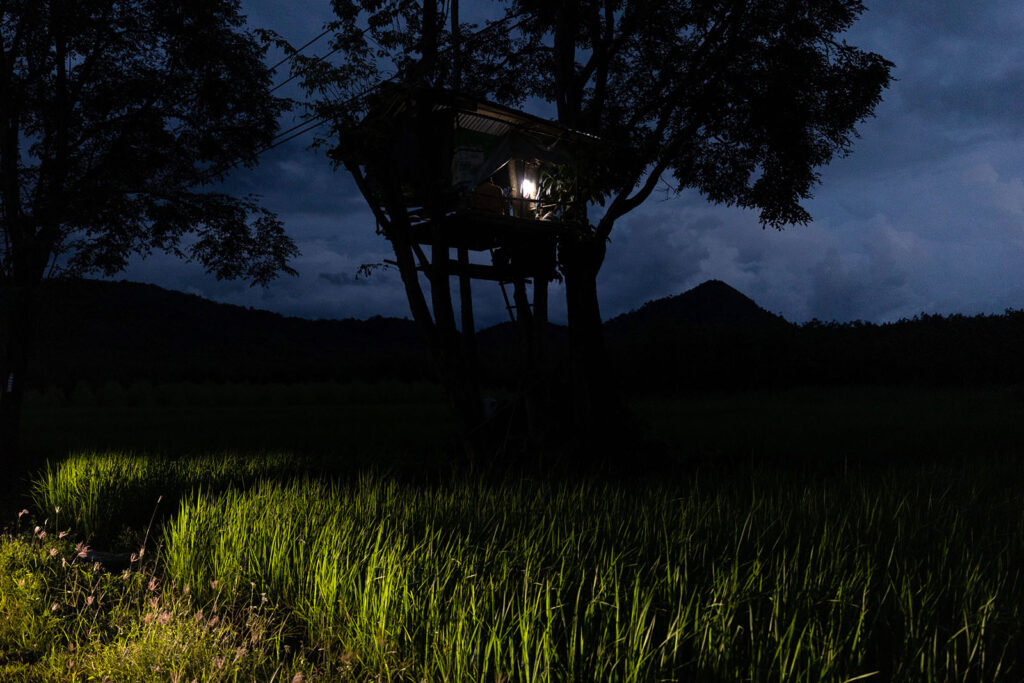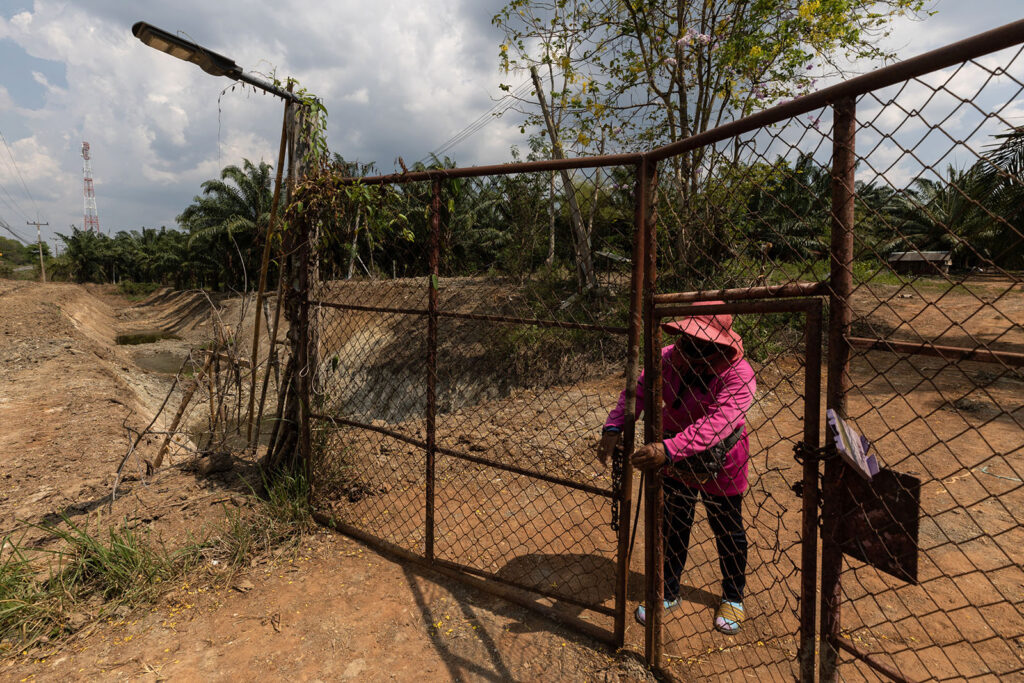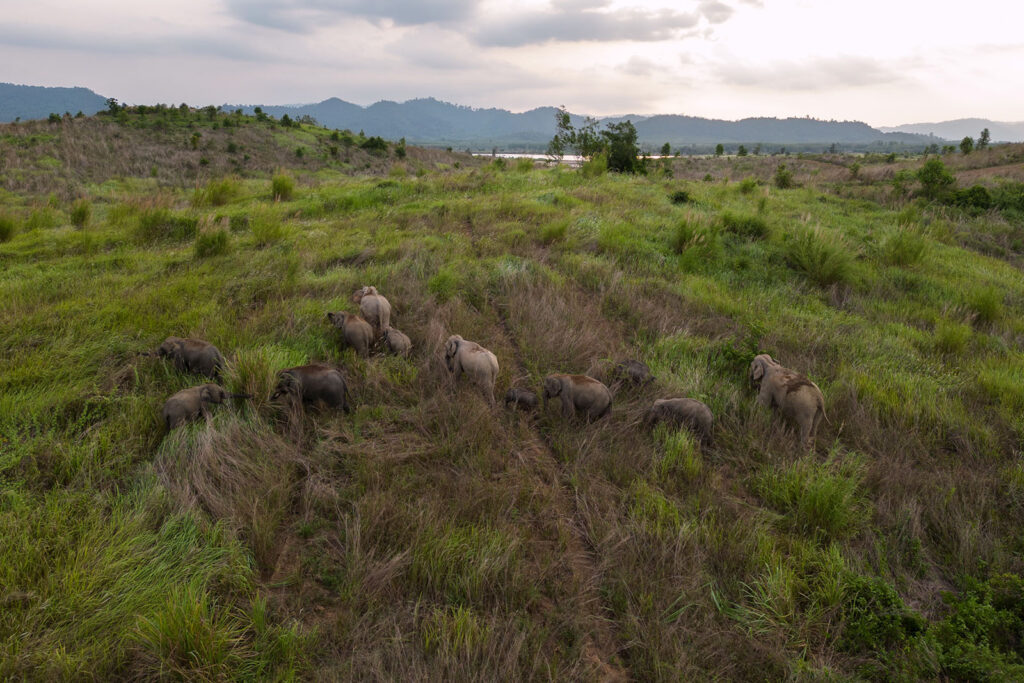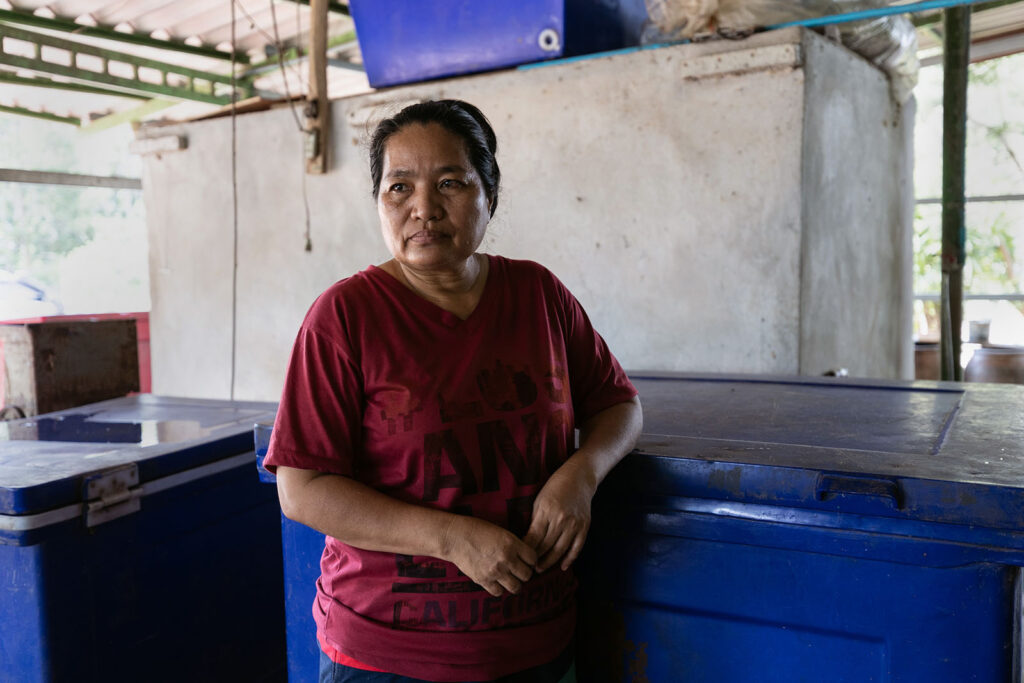
At the beginning of the 20th century, there were more than 100,000 wild elephants living in Thailand. By the early 2000s, fewer than 3,000 remained nationwide as extensive poaching, logging and encroachment into forests severely impacted the population. These actions had put Thailand’s national animal, the elephant, on the endangered species list.
The response was quickly to protect the remaining forests, forming wildlife parks and sanctuaries where the animals could live in safety. But this protection was so effective that the numbers of key species – including the elephant – exploded and certain national parks became unable to sustain this booming population.
As a result, the elephants started to roam, looking for food and new areas outside the forests, leading to Thailand’s most intense and dangerous human-elephant conflict (HEC). Many of the elephants never returned to the original forest and now live almost exclusively amongst the eucalyptus, rubber and palm plantations and occasional community forest within close proximity to villages.
To mitigate the problem, communities formed volunteer groups who are on alert every night and, together with forestry officials, are ready to drive the elephants away from their crops.
But this is dangerous work and would claim many lives on both sides. Between 2012 and 2023, a conservative figure says that 105 people were killed (15 in 2023 alone) by elephants and 133 more injured, while 92 elephants were killed and 46 injured.

As a nonprofit journalism organization, we depend on your support to fund more than 170 reporting projects every year on critical global and local issues. Donate any amount today to become a Pulitzer Center Champion and receive exclusive benefits!
At Khao Ang Rue Nai Wildlife Sanctuary, the heart of the Eastern Forest Complex, the population soon exceeded the park’s carrying capacity and around 15 years ago the first elephants began to venture outside. This put them in direct conflict with the communities that live around the peripheries of the park.
Opinions about possible solutions vary and ultimately there is no perfect answer other than trying to manage this fragile coexistence. But with a birth-rate estimated by Thai researchers to be at 8% per annum in this area, one thing many agree on is that the problem is only going to get worse.
Until then, local communities will be on the frontline to protect their livelihoods and the elephants will continue to search for food and shelter.

Tha Takiap, Chachoengsao province. A group of young male wild elephant walk across a road in a village at night. According to local experts these 3 elephants have only recently left the Wildlife Sanctuary of Ang Rue Nai and therefore have not yet been identified. With an estimated birthrate of over 8% according to local experts and researchers, the estimated population of over 600 wild elephants in this area could have as many as 40 births per year. Image by Luke Duggleby. Thailand, 2023.

Khao Ang Rue Nai Wildlife Sanctuary, Chachoengsao province. After waiting patiently on a road that cuts through the wildlife sanctuary for a truck loaded with sugarcane, this wild elephant stepped in front of the truck, stopping it, so that it could grab trunkfuls of sugarcane before leaving the vehicle to drive on. In the past the wildlife sanctuary of Khao Ang Rue Nai was able to sustain the wild elephant population which lived inside. But around 15 years ago the population reached a point where the sanctuary alone was unable to provide enough territory and food for the elephants. As a result, the elephants started leaving to find food and increase their territory, causing a dangerous on-going conflict between farmers and villagers who live in the areas surrounding the wildlife sanctuary. Image by Luke Duggleby. Thailand, 2023.

Tha Takiap, Chachoengsao province. Member of a volunteer elephant response group, elephant expert and veteran volunteer Panya travels by pickup truck to push a herd of wild elephants away from villagers farmland. The group made-up of village volunteers and forest rangers, they can spend all night expelling the elephants from the farmlands of the community to make sure that the damage done to the crops is minimised. Image by Luke Duggleby. Thailand, 2023.

Tha Takiap, Chachoengsao province. Forest rangers and community volunteers patrol a palm plantations on the edge of their village. Using homemade ping-pong bombs, they are fired with slingshots and make loud explosions, like gun fire, which scares the elephants but doesn’t hurt them. They can spend all night expelling the elephants from the community area to make sure that the damage done to the crops is minimised. It is also very dangerous work and over ten people die every year from elephants. Image by Luke Duggleby. Thailand, 2023.

Tha Takiap District, Chachoengsao. Due to the threat of elephants destroying his rice crop a local farmer called Lung Yai built a treehouse that he sleeps in every-night until his crop is harvested. If elephants come in the night he will call for backup and try to repel them. Image by Luke Duggleby. Thailand, 2023.

Ta Takiap, Chachoengsao. Large areas of eucalyptus plantations interspersed with small hilly islands of forest. This area has one of the worst elephant problems in the east of Thailand with herds of elephants permanently living and moving through this area. Image by Luke Duggleby. Thailand, 2023.

Ko Chan, Chonburi province. Cambodian migrant workers cut down eucalyptus trees which are part of a huge plantation that supplies the paper industry. These vast expanses of eucalyptus trees provide perfect cover for wild elephants and a safe place to sleep during the day. As a result it can make working in such plantations dangerous. Image by Luke Duggleby. Thailand, 2023.

Bo Thong, Chonburi province. Migrant workers from Northeast Thailand harvest a recently burnt sugarcane plantation. It is crops like sugarcane that elephants like to eat and also often rest and sleep in the middle of them, out of sight of people. Image by Luke Duggleby. Thailand, 2023.

Tha Takiap District, Chachoengsao. To stop elephants entering the land and damaging the crops this landowner has spent thousands of euros digging deep trenches around the property. Image by Luke Duggleby. Thailand, 2023.

Sanam Chai Khet District, Chachoengsao. A locally made device used to explode ping-pong bombs sends out loud gun shot sounding noises which scare the elephants without hurting them. Image by Luke Duggleby. Thailand, 2023.

Tha Takiap, Chachoengsao province. Forest rangers and community volunteers fire ping-pong bombs during a patrol of an area of palm plantations on the edge of their village. The homemade bombs are fired with slingshots and make loud explosions, like gun fire, which scares the elephants but doesn’t hurt them. They can spend all night expelling the elephants from the community area to make sure that the damage done to the crops is minimised. It is also very dangerous work and over ten people die every year from elephants. Image by Luke Duggleby. Thailand, 2023.

Tha Takiap, Chachoengsao province. Somnuck Boonprakon, 60, drives past a dam construction site on his way to work. He works as a nighttime security guard, sleeping on the construction site to protect from thieves but also against elephants. The dam site and in fact Somnuck’s own house are visited regularly by wild elephants as they pass through roaming for food at night. Once the dam is completed it will flood a large area causing the elephants to move into new areas. Image by Luke Duggleby. Thailand, 2023.

Nong Yai, Chonburi. Over 40 village volunteers and forestry officials gathered to move a herd of over 50 elephants towards a forested area, away from farmland. The process took from morning until night-time with the elephants refusing to move until after dark. The herd returned the next day. Image by Luke Duggleby. Thailand, 2023.

Wang Chan, Rayong Province. A wild elephant is tracked through villages and rubber plantations by a group of community volunteers and forestry officials who’s aim is to push the animal to return to the forest. They were finally successful by around 3am. Image by Luke Duggleby. Thailand, 2023.

Praket Reservoir, Chanthaburi. A herd of wild elephants roam around the grassy hills of Praket reservoir. This area was where the first wild elephants started leaving the wildlife sanctuary of Ang Rue Nai over 15 years ago. Image by Luke Duggleby. Thailand, 2023.

Kwang Hang Maew, Chanthaburi province. Rubber farmer Bangbon Hongthong, 50, stands at his house holding the photograph used at his daughters funeral. On October 29, 2021, his daughter was killed aged 24 by a wild elephant whilst cutting rubber trees on another plantation. She was his only child and he rarely sees the four grandchildren she left behind. Image by Luke Duggleby. Thailand, 2023.

Tha Takiap, Chachoengsao province. Her husband was killed by a wild elephant just being this house. A forestry official, he had taken the day off to work on his own farmland when he was killed by an elephant just a few hundred meters away from where she stands. Image by Luke Duggleby. Thailand, 2023.

Wang Chan, Rayong province. Chaemchantorn Sanporn, 53, was asleep in her house when a wild elephant forced its way in to her property which sells fish caught from the nearby Prasae Reservoir. Her 92 year old bed-ridden father was sleeping outside at the back of the house under a mosquito net when the elephant frustrated by not finding food picked him up and threw him across the room. He died at hospital. She is still haunted by the noise and by the fact that she was only a few meters away from her father but was unable to help until the elephant had left. Image by Luke Duggleby. Thailand, 2023.

Wang Chan, Rayong province. Janejira Suraprasert remembers clearly when an elephant, seen so often around communities that she was given the name Mango, forced open the sliding metal security door to her shop on March 19, 2020. The CCTV footage of the shop shows the elephant trying to get the food for sale inside the front of the shop. Unable to force the door open entirely and scared away by Janejira’s family she left but not without causing hundreds of euros of damage. Image by Luke Duggleby. Thailand, 2023.

Khlong Lao, Chanthaburi province. Kanitha Ramphingkul, 51, sits on an old durian tree that was one of several knocked down by wild elephants who came to eat the fruit the night before. Her land lies next to the forest boundary and has been raided nightly many times. In total she lost thousands of euros worth of produce and will have to spend years growing a new tree that can bare fruit. Image by Luke Duggleby. Thailand, 2023.

Sanam Chai Khet District, Chachoengsao. Chern Kaewluang, 59, holds a half eaten pineapple discarded by a raiding elephant. He estimates that during this one time, he lost over 250 Euros from loss of sales. His plantation is continuously raided by elephants and he try’s to repel them often using electric wire fences and ping-pong bombs. In fact, Chern lost his left hand trying to repel an elephant with a large ping-pong bomb that exploded before he had time to throw it. Image by Luke Duggleby. Thailand, 2023.

Tha Takiap District, Chachoengsao. Lung Yai stands on a a dirt track next to his rice fields. Due to the threat of elephants destroying his rice crop he built a treehouse that he sleeps in every-night until his crop is harvested. Image by Luke Duggleby. Thailand, 2023.

Tha Takiap, Chachoengsao province. Somnuck Boonprakon, 60, stands at a dam construction site where he works as a nighttime security guard to protect from thieves but also against elephants. The dam site and in fact Somnuck’s own house are visited regularly by wild elephants as they pass through roaming for food at night. Once the dam is completed it will flood a large area causing the elephants to move into new areas. Image by Luke Duggleby. Thailand, 2023.











